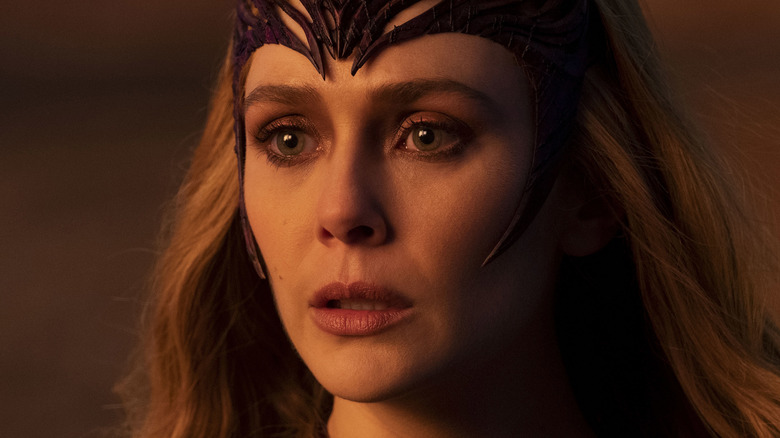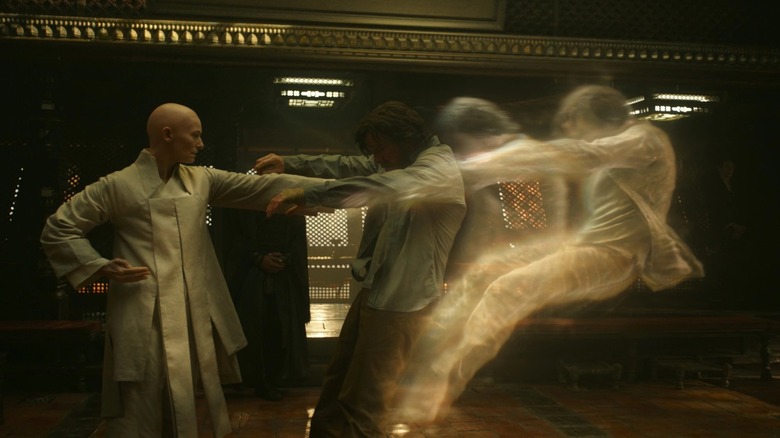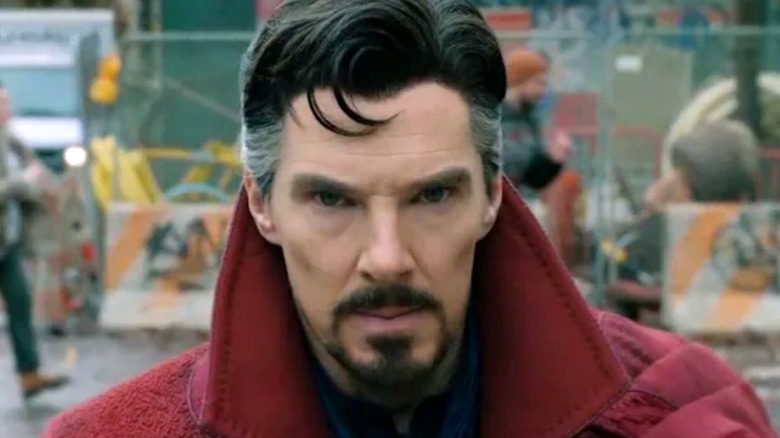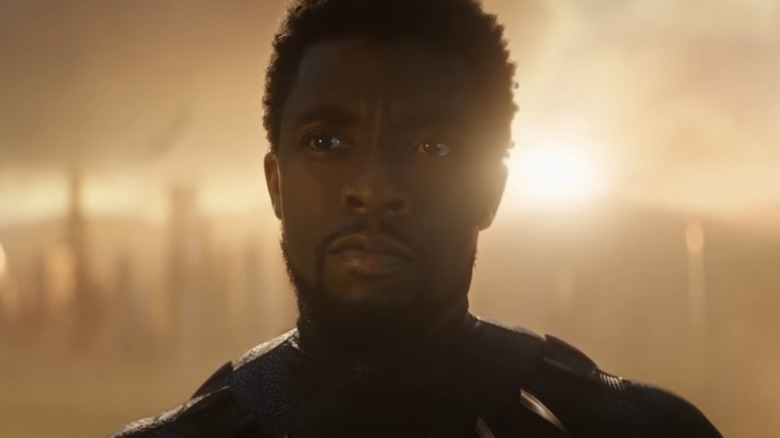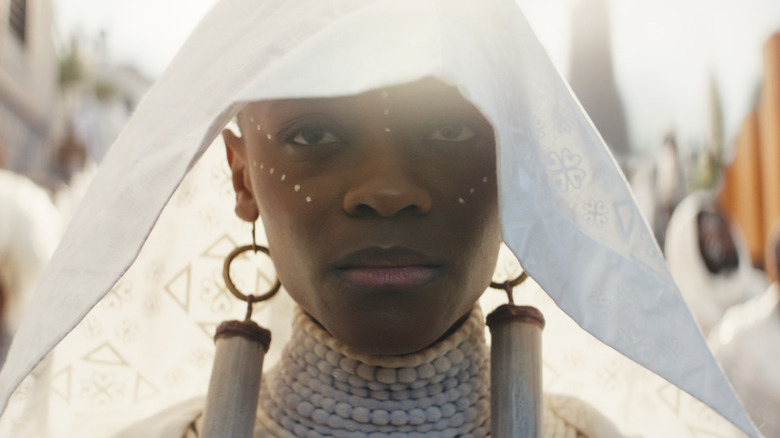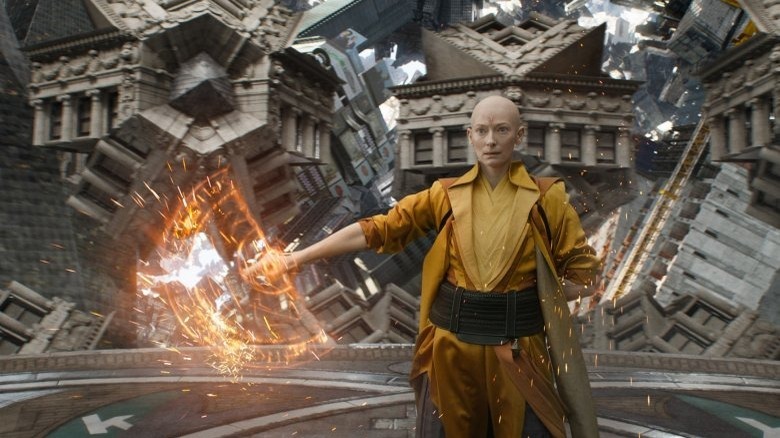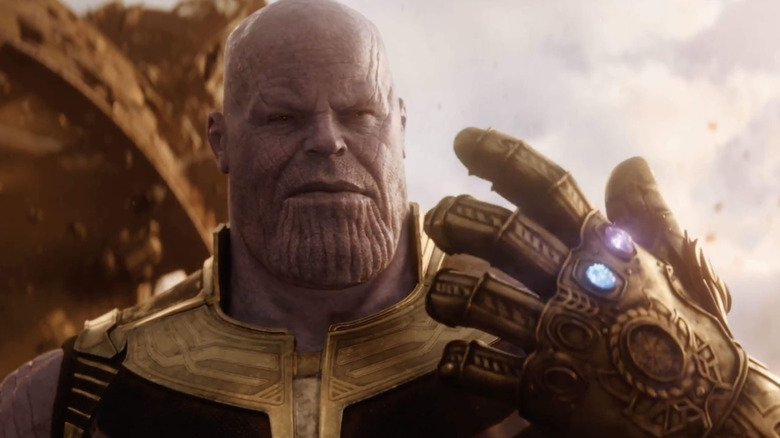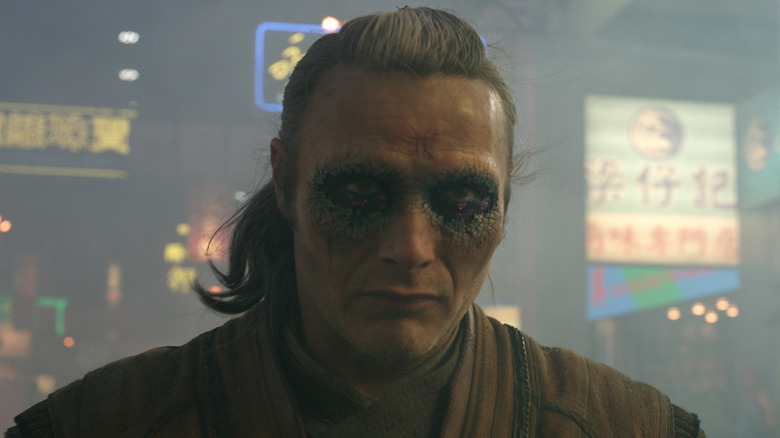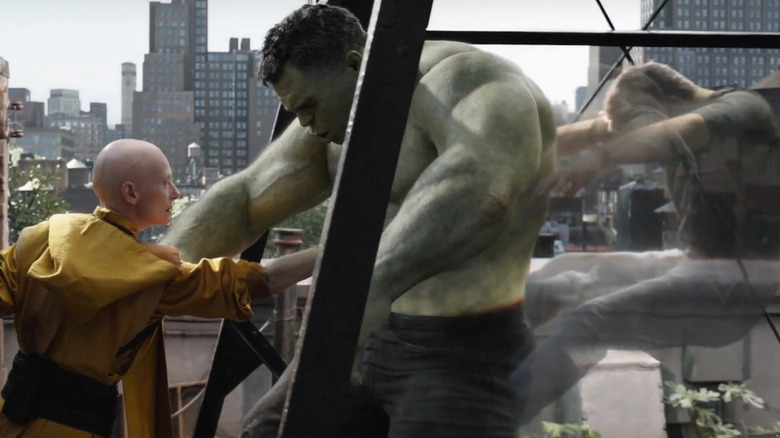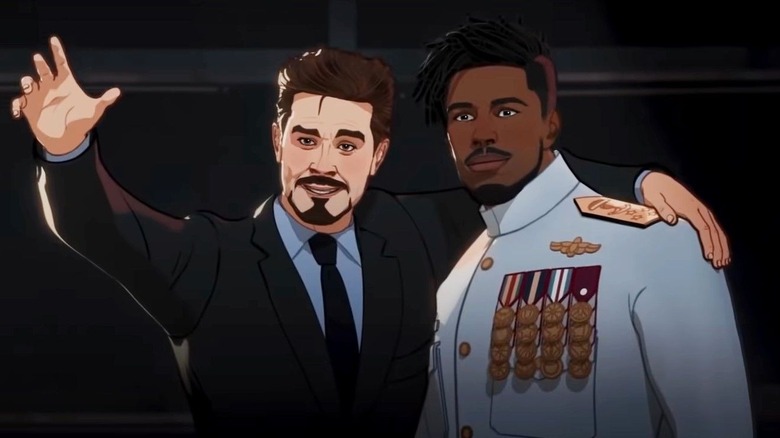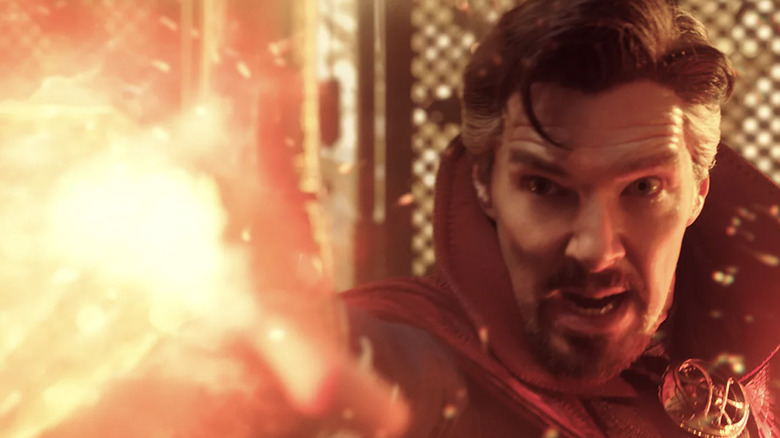Marvel's Astral Dimension Explained
"You didn't believe the Ancestral Plane was real, did you?" These words are spoken by Erik Killmonger in the first "Black Panther," and since then, the mysterious Astral Dimension has only become more prevalent in the Marvel Cinematic Universe. Firmly within the more mystical and spiritual side of Marvel, the realm was originally introduced in the comics as a place outside our own that can be accessed through magical means.
Of course, this concept certainly wasn't invented by Marvel. The idea of astral projection, of willfully separating your mind and body through a kind of meditation, is part of several real-world spiritual beliefs. The concept has been studied and discussed for a long time by curious thinkers, and it's now been popified and popularized through its inclusion in our favorite superhero stories.
The Astral Dimension has now appeared in multiple installments of the MCU, including as recently as "Doctor Strange and the Multiverse of Madness" and "Black Panther: Wakanda Forever." Since it's become so fundamental to the ongoing Marvel storyline, it's essential for any fan of the franchise to have a fuller understanding of what this strange dimension is all about, what its powers are capable of, and how it's been used by different characters. So, read on to have Marvel's Astral Dimension fully explained.
The Astral Dimension requires physical separation
In the real world, practitioners of astral projection believe that it is actually possible to detach your consciousness from your physical body through meditation, or while sleeping. While there's no hard science to support such an idea, there are many people who claim to have experienced these kinds of out-of-body moments first-hand. According to Live Science, as many as 20% of people believe they've felt their consciousness leave their body in some form. Thanks to its prevalence in spirituality and culture, it should come as no surprise that astral projection has become a popular part of franchises like the MCU.
Within the Marvel Cinematic Universe, the first time we see any kind of astral projection is in the first "Doctor Strange” film. By watching Steven Strange learn the mystic arts, we begin to learn what's required for a person to access the Astral Dimension. What quickly becomes clear is that one must separate from their physical form in order to bring their consciousness into the astral plane, since Dr. Strange does this multiple times throughout the MCU. One notable example is when Strange's soul is separated from his sleeping body so that he can continue reading in the Astral Plane.
Time moves differently there
Time works very differently within the MCU's Astral Dimension. According to a scene in the first "Doctor Strange," time is apparently much slower on the Astral Plane when compared to our material world. At one point early on, Dr. Strange gets separated from his body and is able to commune with the Ancient One on the astral plane for a prolonged period of time while his body is falling through the air. He's able to have an entire conversation with his mentor and return to consciousness before he ever hits the ground.
It's also clear through the "Black Panther" movies that Wakanda's Ancestral Plane is part of the same realm of existence as the Astral Dimension, and that it has the same kind of time-dilation effects for those who access it. In the first film, T'Challa is able to commune with his deceased father on the Ancestral Plane without losing any time in the real world to do so. His arch-rival, Killmonger, does the same thing with his father as well. While the exact nature of the Astral Plane's effect on time is never explicitly explained, it's clear that it does slow things down for whoever's there — much like how the Quantum Realm from the "Ant-Man" movies exists outside of spacetime as well.
Multiple MCU characters have accessed the Astral Dimension
While the Astral Plane is first introduced in the MCU as Dr. Strange's domain (as well as other followers of the mystic arts), it has since been expanded to be accessible by multiple other heroes and villains. Some of the first characters who we see going into the Astral Dimension fit within the more mystical side of the Marvel universe, such as Dr. Strange and the Ancient One. Yet, even street-level heroes like Spider-man have been separated from their bodies to experience the dimension too.
We know for a fact that powerful magic users can project themselves into the Astral Dimension, as we see Scarlet Witch doing just that following the end of "WandaVision." Individuals can also be forcibly sent to the Astral Dimension against their will. This is what happens to Spider-man during the events of "Spider-man: No Way Home" when Dr. Strange ejects Peter Parker's soul from his body to stop him from running away with the Macchina di Kadavus. Other notable characters to visit the Astral Plane are Black Panther, Killmonger, Lucian Aster, Wong, Shuri, Moon Knight, Bruce Banner, and Queen Ramonda.
Deeply intertwined with Wakandan traditions
Although it goes by a different name when discussed in the "Black Panther" series, it turns out that the Astral Dimension and the Wakandan Ancestral Plane are actually in the same realm of existence. To Wakandan characters like T'Challa and Shuri, the Ancestral Plane is a place beyond the material realm where they believe their souls will go after death. It is featured heavily in both "Black Panther" and "Black Panther: Wakanda Forever" as a location both that the characters access following personal tragedies.
In "Black Panther," both T'Challa and his nemesis Killmonger enter the Ancestral Plane at different times to interact with the spirits of their fathers. T'Challa greets T'Chaka after being buried in the City of the Dead catacombs and given the Heart-Shaped Herb, which is essential for accessing the Ancestral Plane while alive. While there, T'Challa reconnects with his father's spirit and asks for some guidance on how to rule Wakanda in his absence. Killmonger, on the other hand, takes the same herb and sees N'Jobu in his childhood home.
By the time Shuri accesses the Ancestral Plane in "Black Panther: Wakanda Forever," many things have changed in the MCU. Killmonger destroyed the remaining Heart-Shaped Herb plants, then died, and T'Challa passed away later from a mysterious illness. By creating a synthetic herb, Shuri is able to journey to the Ancestral Plane herself, but her experience there forces her to interact with her former enemy Killmonger at a particularly dark moment.
You can die while in the Astral Dimension
Although the Astral Dimension seems like a place beyond life and death (especially for Wakandans visiting already dead loved ones there), it has been proven in the MCU that a soul can die there while still being separated from its body. This has only really happened once so far, but it's a particularly emotional and notable moment of an incredibly powerful sorcerer passing away in two different forms.
In the first "Doctor Strange" movie, the Ancient One serves as Strange's mentor and leader as he becomes immersed in the world of magic. She is the first Sorcerer Supreme we meet in the MCU, and as a result, she wields incredible power, demonstrated when she fights off the forces of her evil former apprentice Kaecilius. Yet, despite all her power, she remains a mortal — susceptible to the same fatal injuries as anyone else. After being stabbed in battle, the Ancient One is brought to a hospital where her soul separates from her dying body to talk with Dr. Strange in the Astral Dimension one last time. It's there in the Astral Plane that the Ancient One's long life comes to an end while her consciousness is already projected outside her physical form.
Before passing on, she leaves Strange with a powerful piece of advice: "We don't get to choose our time. Death is what gives life meaning, to know your days are numbered — your time is short. You'd think after all this time I'd be ready. But look at me, stretching one moment out into a thousand, just so that I can watch the snow."
Infinity Stones can overpower it
The Infinity Stones play a critical role in the MCU, having made appearances in various forms since Phase 1. They became the central, all-powerful objects of the franchise when Thanos completed his collection of them and wiped out half of all life in the universe during "Avengers: Infinity War." Despite a comical appearance during the Disney+ series "Loki" where they're little more than glorified glowing paperweights, the Infinity Stones have consistently been portrayed as weapons of mass destruction that can apparently even have an influence on the Astral Dimension.
Although the Astral Dimension is outside the bounds of the material world, it's apparently still subject to the godly power each Infinity Stone can wield. After all, the Infinity Stones were created right alongside the universe itself during the Big Bang. Each one has a different ability tied to a fundamental aspect of the universe: Space, Power, Reality, Soul, Time, and Mind. During "Avengers: Infinity War," we learn how one of these gems has a direct impact on Doctor Strange's ability to utilize the Astral Dimension during a battle with Thanos himself. By using the Soul Stone, Thanos is able to forcibly separate Strange's soul from his physical body during combat. Being able to do this to as powerful a sorcerer as Doctor Strange is unthinkable, but that just goes to show how powerful these relics can be.
The Astral Plane can be used for good or evil
When one hero uses a power for good in the Marvel Cinematic Universe, there's a high probability that some villain will embrace the same power for their own gain. This trend began at the very beginning with 2008's "Iron Man," in which Obadiah Stane creates his own suit of high-tech armor to do battle with Tony Stark for control of his company. Since then, there have been countless examples of Marvel villains finding twisted ways to turn the powers and abilities of heroes against them, or corrupting them in some way. Unfortunately, the Astral Dimension also falls prey to this trope.
In "Doctor Strange," as Steven Strange is learning about the mystic arts, there are evil-doers simultaneously wielding the same magic for an immoral cause. Kaecilius is a former student of the Ancient One who's been corrupted to serve the dark entity Dormammu, and as a result, he's been attacking the Masters of the Mystics Arts through the Astral Dimension. His zealous servants like Lucian Aster even fight with Doctor Strange one-on-one within the Astral Dimension while their souls are separated from their physical bodies. More recently, Scarlet Witch has embraced the darker side of magic by reading from the Darkhold, an unholy book that teaches evil spells and enchantments. In order to save herself time and energy, Wanda learns from the book while in the Astral Dimension, which gives her more intimate access to its contents.
Bruce Banner and the Hulk can be split through the Astral Plane
As mentioned earlier, the Astral Dimension can only be accessed once a person has separated their soul from their physical form. But this leads to some questions regarding the more complicated and emotionally divided characters in the MCU, who are in many ways multiple beings in one body. The Hulk is the most notable example of this dynamic, since Bruce Banner and the Hulk are two separate beings who fight for control of the same physical body. How does this character operate in the Astral Dimension? Well, that question was finally answered in "Avengers: Endgame."
During the film's elaborate time heist, the remaining living members of the superhero team are sent across various timelines to steal the Infinity Stones before Thanos can get them. This leads the so-called "Smart Hulk" (the melding of Banner and Hulk into a single being) to stop by the Sanctum Sanctorum in New York City to gather the Time Stone from the Ancient One. During the conflict between them, the Ancient One forcibly separated Bruce's soul from his Hulk body, leaving him suspended in a harmless form within the Astral Dimension. Luckily, they're able to talk things out, and she gives him the Time Stone willingly, but it's fascinating to see Bruce temporarily freed from his gamma-ray burden by entering this otherworldly realm. Something similar happens in the Disney+ series "Moon Knight," where the multiple personalities of Marc Spector function as distinct souls within the Egyptian underworld of Duat (which is also in the Astral Dimension).
The Astral Dimension exists in multiple realities
With all the multiverses, time travel, and cosmic connections continuing to be introduced in the Marvel Cinematic Universe, it can get a bit confusing to keep all this stuff straight. Although the Astral Dimension has been firmly established thanks to "Doctor Strange" and "Black Panther," it may still leave fans wondering where this non-material world exists within the greater multiverse.
Well, one thing is clear: The Astral Dimension exists in multiple realities across the multiverse. Whether or not it exists in all of them is unlikely since the multiverse is theoretically infinite and, statistically, a universe may be out there with no access to the Astral Dimension whatsoever. But we can only prove what we've seen in Marvel's films and shows, which have featured the Astral Plane beyond our own universe.
Because of how time travel works in Marvel (which is still pretty confusing), when the Hulk takes the Time Stone from the Ancient One in the past, it's actually more like hopping into a different reality. So, Bruce Banner and the Hulk being split through the Astral Dimension is the first piece of evidence showing it's accessible in other realities. This happens again in an episode of "Marvel's What If...?" where Killmonger (now the King of Wakanda after killing T'Challa) enters the Ancestral Plane and has a prolonged conversation with his predecessor. Once there, T'Challa says, "Power, unearned, can be a very volatile force, cousin. It'll get the best of you, eventually. On your plane, or on ours."
The Astral Plane is essential for Doctor Strange to become the Sorcerer Supreme
Doctor Strange is one of the most powerful characters in the Marvel universe thanks in no small part to his deep understanding of the mystic arts. At this point in the timeline, he's a seasoned sorcerer, master of the New York Sanctum, and a former Sorcerer Supreme with the skills to match. Yet, Steven Strange was not always the caped magician he's known as in recent installments such as "Doctor Strange and the Multiverse of Madness." Given all that he's accomplished in the franchise, it's easy to forget that there was a time when this character didn't believe in anything remotely mystical at all.
2016's "Doctor Strange" is a mostly straightforward origin story that introduces Doctor Strange as a no-nonsense and arrogant surgeon — a man who would never have dived into the mystic arts if not for the tragic accident that cripples his hands. During his desperate search for a way to heal his body, he finds Kamar-Taj and the Ancient One. This is where the Astral Dimension comes in. Doctor Strange is completely unwilling to accept the possibility of other dimensions at all — that is, until he's forcibly separated from his physical body by the Ancient One. Experiencing both the Astral Plane and the Mirror Dimension is what allows Steven Strange to truly open his mind to sorcery. Fortunately for him, and the larger MCU, he ends up excelling at the skill.
